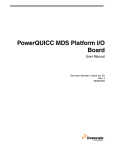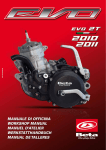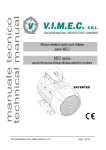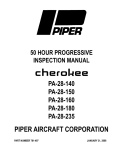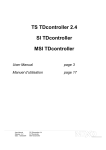Download 7602030 ASSEMBLY INSTRUCTIONS
Transcript
7602030 ASSEMBLY INSTRUCTIONS CONTENTS OF THE MANUAL 1. System supply condition Page 18 2. Positioning the lower rail Page 19 3. Positioning the upper rail Page 21 4. Trolley assembly Page 22 5. Power supply unit connection Page 24 6. Installer pushbutton connection Page 24 7. Connection feet final assembly Page 25 8. Bars assembly Page 26 9. Assembling the platform with motorized access frontal Page 27 10. Assembling the platform Page 30 11. Temporary assembly of the dome for installation check Page 31 12. Checks on installation Page 31 13. Rolls for curve regulation Page 32 14. Slides supports adjustment Page 32 15. Guide thickening (optional) Page 32 16. End stop cams and middle stop assembly Page 33 17. Cam placement and extrarun plates check Page 34 18. Final testing Page 34 19. Fitting the casings Page 35 20. Plugs and terminals assembly Page 35 17 7602030 1) SYSTEM SUPPLY CONDITION CAUTION: Disassebmle the bars groups (Fig. 1/c) before inserting the saddles in the guides. The stairlift is supplied subdivided into the following components: Lift structure (Fig. 1/a) Complete with gear motor, drive components with safety gear and electrical system. Carrier platform (Fig. 1/b) Complete with guard boards and sensor base with safety microswitches. Bars unit (Fig. 1/c). Fixed, or retractile safety bars (optional). FIG.1 Bonnet/Cover unit and inboard pushbutton (Fig. 1/d). CAUTION: Disassemble the upper and rear bonnets (Fig. 1/d) before inserting the saddles in the guides. Rail unit (Fig. 2) Comprising: - Lower guide kitted with busway and support feet (Fig. 2/a). - Upper guide (Fig. 2/b). - Securing fittings. d c d d c a b FIG.2 b b a 18 7602030 FIG.5 2) INSTALLING THE LOWER RAIL - Using the proper assembly punching (Fig. 3/b), locate the first guide section in which is the curve (Fig. 3/a) starting from the high plan. NOTE: If there are no curves, locate the first rectilinear section (Fig. 4/a) always starting from above. - Position the curve in the installation point (Fig. 6/c). - Taking as reference the values in the assembly diagram (example Fig. 5) slide-off the feet and lightly tighten just one screw (Fig. 6/a) of each connection device (Fig. 6/d). NOTE: Make sure the outer side of the guide stands at FIG.3 b FIG.6 d a d a A B FIG.4 a c 160 a C b D FIG.7 a A 19 7602030 160 mm (Fig. 6/b) clear from the handrail of the separating wall. - Put the curve connection devices in vertical position (Fig. 7), tightening both securing screw (Fig. 7/a) at the end of the adjustment. CAUTION: The couple for the tightening of the guide securing screws (Fig. 7/a) must be 6-7 daNm. - Using the proper assembly punching (Fig. 3/b), locate the guide section with feet (Fig. 8/a) to position right above the formerly positioned curve (Fig. 8/b). - Position the guide in the installation point (Fig. 8/a), taking as reference the values in the assembly diagram (example see Fig. 5) slide-off the feet and lightly tighten just one nut (Fig. 8/c) of each connection device (Fig. 8/d). - Insert in the upper guide tube (Fig. 9/a) the joint plates (Fig. 9/e), screw without tightening the first 2 grub screws.(Fig. 9/f). - Draw near the low guide section (Fig. 9/b), assemble the remaining grub screws and tighten them with a 8-9 daNm couple after verifying the correct tubes alignment and the lack of space between one tube and the other. Assemble the bus-way joint as shown in figure (Fig. 9/ d) after verifying the components cleanliness. - As already done for the curve, set the connection devices in perfectly vertical position (Fig. 8/e), tightening both securing screws (Fig. 8/f) at the end of the adjustment. - Carry out the installation of all guide sections except the last one as formerly described down to the bottom of the scale. FIG.8 d e c ± 1° max C a f D c d A b FIG.9 h d c g a c b f e 20 7602030 FIG.11 In order to facilitate the assembly operation for the wall fastening (Fig. 10/a), it is advisable using the special test feet (Fig. 10/b) (ask the Vimec service department, as they are not supplied) to insert on the guide instead of the middle fastenings (almost 1-2 every ramp). a c NOTE: Before carrying out any machine handling test, the connection (Fig. 10/a) must be fixed to the wall. 3) INSTALLING THE UPPER RAIL - Position the spacing gauges (Fig. 11/a) (ask the Vimec service department, as they are not supplied), on the extreme edges of the first positioned guide section (Fig. 11/b) (curve) and block them hard rotating the lever as shown in figure (Fig. 11/c). - By loosening the handwheel (Fig. 12/a) and using a spirit level (Fig. 12/b), position the support arm (Fig. 12/c) in perfectly vertical position. Once the adjustment has been done, tighten the handwheel hard (Fig. 12/a). - Position the upper guide (Fig. 13/a) on the spacing gauges (Fig. 13/b) formerly positioned, and after having checked the correct vertical sense (Fig. 13/c), tighten the screews (Fig. 13/d) hard. CAUTION: The couple securing the guide fixing screws (Fig. 13/d) must be 6-7 daNm. b a FIG.12 c - Carry out the assembly of all the guide sections remained, proceeding in sequence as formerly described down to the bottom of the scale except the last one. If included in the kit, insert the cable for push-button panles (Fig. 12/e) during the guides connection. - When finished the assembly, retouch guides with supplied black paint and seal the screws (Fig. 9/g) and the nuts (Fig. 9/h) of the busway junction. a FIG.10 b FIG.13 d e b a b c 0±1 mm a 21 7602030 FIG.15 4) TROLLEY ASSEMBLY - Position the structure kitted with trolleys in the parking zone at low plan. - Completely fasten the screw M10x30 (Fig. 15/a) with washer (Fig. 15/b) on the friction block in order to release the upper platform balance from the friction group; the correct space is obtained when the clutch group is about 2 mm clear from the swaying trolley (Fig. 15/c). - Loosen the brush-holder fastening screw (Fig. 14/a) and rotate it as indicated by the arrow (Fig. 14/b) or pull the brushes backwords (Fig. 14/c) during the introduction of the tube in the lower trolley. NOTE: During the stages described as follows, pay much attention to the correcto positioning of the slides (Fig. 17/f - 18/e) after having lubricated them with grease. - Insert the lower tube (Fig. 16/a) in the lower swaying trolley (Fig. 16/b) remembering, if they have not been slewed (Fig. 14/b), to draw back the brushes (Fig. 14/c). - Insert the lower tube (Fig. 17/a) in the swaying trolley (Fig. 17/b) making sure that the teeth of the dragging pinion (Fig. 17/e) correctly match with the holes, until carrying out the junction of the guide with the one formerly prearranged (Fig. 17/c). - Carry out the junction of the busway (Fig. 17/d) as previously described. b a c FIG.14 FIG.16 b a b SOLUTION "A" c a c SOLUTION "B" 22 7602030 FIG.18 - Insert the upper tube (Fig. 18/a) in the swaying trolley (Fig. 18/b) and, with the help of the upper handwheel, (Fig. 18/c), insert it up to execution of the junction with the tube (Fig. 18/d) previously prearranged. e - In case of former opening of the brush-holding group (Fig. 19), rotate it to the initial position. b c d - Manually press the unit (Fig. 19/c) in the direction indicated by the arrow (Fig. 19/d) till making both the brushes re-enter at least 5 mm. - Keeping the unit (Fig. 19/c) pressed against the guide (Fig. 19/e) tighten hard the screws (Fig. 19/a and 19/f). CAUTION: Do not let the connection cables lean out from the brush-holder overall dimensions to guarantee the protection carter a perfect closing. - If provided fix the resistance with two self-tapping screws to the brush-holder and connect the two cables to the points “A” e “B” (Fig. 19). e - Screw-out the screw (Fig. 15/a) and its washer (Fig. 15/b) to couple back the clutch unit with the swaying trolley and remove the support feet (Fig. 18/f). FIG.17 a c f f FIG.19 b e d e d a f a f b B c A d c 23 7602030 Once the guide assembly is through, for machine with costant gradient lower than 20°, check the slant of the whole guide (maximum allowed error 1°) before sarting the machine up (see Fig. 20). - Raise the machine a bit, in order to reset it. - Slack the screw (Fig. 15/a) and its washer (Fig. 15/b) to couple back the clutch unit with the swaying trolley. FIG.21 5) POWER SUPPLY UNIT CONNECTION e - Connect the cables (positive and negative) to the proper terminal of the busway fixed to the guide (Fig. 21/e Fig. 21/f). - Connect the electric power 230 V 50 Hz to the suitable socket (Fig. 21/c). - d - At the end of installation, give tension through the main switch (Fig. 21/d). f 6) INSTALLER PUSHBUTTON CONNECTION - Connect through suitable connection socket the installer pushbutton (Fig. 22/a) (require it to Vimec service department, as it is not supplied). - By means of the (Fig. 22/b - Fig. 22/c) previously described pushbutton panel controls take the structure complete with trolley on the selected floor to continue the assembly operations with total safety. c - Insert the spacing gauge (Fig. 23/g) between the guides and assemble the connection/foot (Fig. 23/a). FIG.22 - After having correctly spaced the guides (Fig. 23/b Fig. 23/c) with the spacing gauge (Fig. 23/g) and after having perfectly placed in vertical position the connection (Fig. 23/a), tighten the screws hard (Fig. 23/e and Fig. 23/f). - a b + b c st NOTE: Lift the machine up to the 1 rigid connection, if the machine is not horizontal, screw in the screw M10x30 (Fig. 15/a) with washer (Fig. 15/b) in the clutch unit in order to clear the upper swaying trolley from the clutch unit. The correct space is obtained when the clutch unit is about 2 mm clear from the swaying trolley (Fig. 15/c). a FIG.20 POS. DRIVING TORQUE (daN x m) 1 2,5 2 6,0 3 4,5 3 1 2 2 3 3 24 + 7602030 7) CONNECTION FEET FINAL ASSEMBLY FIG.24 After having done a test operation to make sure that everything has been correctly assembled, it is necessary to fix the support feet to the ground and the connections (where possible) to the wall. According to the type of foot foreseen in the assembly diagram, fix it hard as shown in the following examples (Fig. 24-25-26-27). In case of step-fixing foot (Fig. 27), drill the same steps and block it all with the issued screws (Fig. 27/a). After the fixing operation, tighten the screws hard (Fig. 27/b). In case of flag-support foot (Fig. 26), drill in the fixing points and block it all with the issued screws (Fig. 26/ a). Tension the foot (Fig. 26/c) introducing the threaded bar in the proper holes (Fig. 26/b) and screwing in the nut and the counternut (Fig. 26/d) up to reaching of the tensioning. FIG.25 To avoid guide inclination changings (Fig. 28/a) in the future, it is necessary to drill a hole (Fig. 28/b) on the connection joint (Fig. 28/c), after having furthuerly checked the correct assembly, and then insert a blocking peg (Fig. 28/d) in that same hole. FIG.23 c e d f a g b 25 7602030 FIG.28 8) BARS ASSEMBLY a b Mount the bars supports (Fig. 29/b) on the machine frame (Fig. 29/a) making the corresponding reference pins (Fig. 29/c) match. c d Tighten the bars with the proper issued screws (Fig. 29/d). Then, proceed to connection of the electrical card sheaths. 8.1) Indipendent bars - Connected bars Connect the cable in the lower part of the bar (Fig. 29/e) with the footboard interblock system (Fig. 29/f). 8.2) Retractile bars Connect the lever in the lower part of the bar (Fig. 29/g) with the screw and the self-locking nut (Fig. 29/h). FIG.29 FIG.26 a d d c d c c b b e b d a f FIG.27 a d c d c a b b g a h 26 7602030 9) ASSEMBLING THE PLATFORM WITH MOTORIZED ACCESS FRONTAL (B.I. - B.C. - B.R.) f) Connect the lateral guard board operating cables (Fig. 34/f) and frontal (Fig. 34/e) to the fork (Fig. 34/b). On customer request it is possible to have a footboard with overturning front side (Fig. 30/a). - Tighten with nut and screw. - Insert the eccentric (Fig. 34/h) with handling belt (Fig. 34/g), front chute on the special pin (Fig. 34/i) and block with seeger (Fig. 34/m). Such a footboard permits, on the lower floor only, to access/go down perpendicularly to the machine. B. R.: fix the cable (Fig. 34/f) already present on the side bar chute with special screws. 9.1) Assembling the platform a) Remove the top plate from the platform by undoing the relative screws. - Fix the cable eye (Fig. 34/e) to the eccentric (Fig. 34/ h) by screw, nut and lock nut leaving the necessary clearance for the rotation of the eye itself. b) Make sure that the two platform supports, fixed by a wedge and a plastic clamp, are in the assembly position (Fig. 33/a/b). FIG.31 c) Fit the platform, keeping it vertical and turning it through 90° as shown in (Fig. 31). d) Fix the platform to the frame using the relative M8 flathead screws (Fig. 31/a) e) Fix the two microswitches of the sensor base (Fig. 32/a) to the platform, passing them between the sensor base and the platform frame (Fig. 32/b). If necessary, back off the sensor base tripping cams (Fig. 32/c) to allow the microswitch to pass. Then restore the original positions so that the sensor base trips the microswitches when it is pressed. a FIG.30 FIG.32 b c a a a 27 7602030 FIG.33 a b c d 125 FIG.34 b d e b f a c e m i h g 28 7602030 to the specified position using the register fork (Fig.34/b). Proceeds to check the proper working of the front access chute: g) Replace the top plate on the platform using the relative fixing screws. - Check the angle between the chute (in working position) and the footboard is 90° (Fig. 35). h) Remove the wedge and the plastic clamp (Fig. 33/c/ d) used to keep the platform horizontal during the adjustments from the platform supports. - Check the front access micro chute intervenes with a maximum rotation of 30° of the same chute with respect to the working position as in Fig. 35. i) Tighten with a driving torque of 4 daN ± 0,1the dowel, the nut and the locknut (Fig. 36/a,b). - If the guards are not opened or closed correctly, adjust FIG.35 FIG.36 b FIG.37 a b c d 29 a 7602030 FIG.39 10) ASSEMBLING THE PLATFORM b a) Remove the top plate from the platform by undoing the relative screws. b) Make sure that the two platform supports, fixed by a wedge and a plastic clamp, are in the assembly position (Fig. 37/a/b). c) Fit the platform, keeping it vertical and turning it through 90° as shown in (Fig. 38). d) Fix the platform to the frame using the relative M8 flathead screws (Fig. 38/a). c e) Fix the two microswitches of the sensor base (Fig. 39/a) to the platform, passing them between the sensor base and the platform frame (Fig. 39/b). a Then restore the original positions so that the sensor base trips the microswitches when it is pressed. FIG.40 f) Connect the lateral guard board operating cables to the relative bar actuators, passing them around the pin (Fig. 40/a). b 125 a If necessary, back off the sensor base tripping cams (Fig. 39/c) to allow the microswitch to pass. If the guards are not opened or closed correctly, adjust to the specified position using the register fork (Fig.40/ b). g) Replace the top plate on the platform using the relative fixing screws. h) Remove the wedge and the plastic clamp (Fig. 37/c/ d) used to keep the platform horizontal during the adjustments from the platform supports. a i) Tighten with a driving torque of 4 daN ± 0,1the dowel, the nut and the locknut (Fig. 41/a,b). FIG.38 FIG.41 a b 30 a 7602030 11) TEMPORARY ASSEMBLY OF THE DOME FOR INSTALLATION CHECK - Restore the power supply and press the down button until the hook engages. The stairlift will stop when the safety microswitch is pressed by the hook. On completion of the machine mechanism assembly it is necessary to carry out the temporary assembly of the upper dome. - Reset the safety gear by moving the stairlift upward in manual mode (see point 7.6). To carry out this assembly it only takes vertically rotating the prearranged-to-this-aim brackets (Fig. 42/a) and fixing the dome overmachine (Fig. 42/b). Carry out the electrical connections and then the following checks described below. e) Stability of the rail Check all the fixing screws o the connections to the mounts and all expansion plugs present. f) General checks Check all moving parts, the guards, labels and signs. Check the batteries condition and the indicator lights of both the power supply units. 12) INSTALLATION CHECKS - Check that the operating mode setting switch (JB22 JB23) is set as appropriate to the system type (RH or LH). - Check that the jumpers are according to the electric system. FIG.42 b - Check that all the lifts and microswitches working are correctly positioned,consulting the electrical system diagrams provided. - Verify also all controls correct working. a a) Safety devices Check that on contact with an obstacle, the anti-impact and anti-shearing sensors stop the lift and allow it to be started in the opposite travel direction. Check that the stopping positions at the floors provided by the limit switches are to requirements. a b) Electromagnetic brake The electromagnetic brake on the motor must stop the lift when fully loaded before the overlimits stop device is tripped. If necessary, replace the whole brake. c) Drive mechanics Check that the teeth of the drive sprocket and the nylon wheels on which the lift runs are not worn or damaged. There must be no grooves or flattening on the wheels. Check that the chain is not worn. d) Safety gear Check that the hook device is free to operate without friction or excessive backlashes and that it trips the safety microswitch correctly. To check operation of the safety gear, proceed as follows: - Move the stairlift 1-2 metres from the floor. - Disconnect the power supply by turning the master switch to OFF. - Remove the protective panel (Fig. 1/d). - Press the safety ear hook with a wooden/plastic rod. CAUTION: Keep well away from all un- protected moving parts. 31 7602030 FIG.44 13) ROLLS FOR CURVE REGULATION On the less sloping curve (Fig. 43/a) place till touching the guide, the rolls for curve (Fig. 43/b). At the end of the regulation tighten the rolls fastening screws (Fig. 43/c) with a 2 daNm couple. This regulation will be kept also for other curves on which the contact will be guaranteed by proper thickening (Fig. 43/a) (optional). Make sure the machine is properly working without any jolts and vibrations in curve. On the contrary adjust the curve thickening not on level ground. 14) SLIDES SUPPORTS ADJUSTMENT Adjust the slides support using the screws (Fig. 44/a) in order to obtain a 0,5 ± 0,5 mm distance between slide and guide (see Fig. 44). 15) GUIDE THICKENING (OPTIONAL) In case of curves where rolls (Fig. 45/b) should not touch the guide (Fig. 45/c) it is necessary to fix proper thickening profiles as shown in Fig. 45/a. Thickening then must be chosen in order to reduce to minimum the rolls clearance (Fig. 45/b) guide clearance (Fig. 45/c) without causing excessive frictions or strains. FIG.43 a a FIG.45 b a c b b b c 32 a 7602030 16) LIMIT STOP CAMS AND INTERMEDIATE STOP ASSEMBLY - Nel caso di fermata intermedia (Fig. 47/a) assembly the support (Fig. 47c) on the tubular (Fig. 47/d) by means of two dowels M8x30 (Fig. 47/e). Assembly the cam stiffening bracket (Fig. 47/f), the spacer (Fig. 47/g), and the bracket cam fixing bracket (Fig. 47/h) with screws TSPCE M8x16 (Fig. 47/n) and TSPCE M8x35 (Fig. 47/i). Assembly the cam (Fig. 47/l) with N°2 screws TSPCE M5x20 (Fig. 47/m). Place the cam at a distance of 177 mm from the lower side of the upper guide tube, and at 30 mm from the machine centerline axis traced before (Fig. 47/b). - Bring the stairlift to the stop position (Fig. 46/a - 47/a - 48/a) tracing on the tube guide the centerline axis of the machine (Fig. 46/b - 47/b - 48/b). - Move the machine. - In case of upper (Fig. 46/a) or lower (Fig. 48/a) stop, assemble the proper limit switch cam (Fig. 46/e - 48/ e) using screws, nuts and washers (Fig. 46/c - 48/c) and support (Fig. 46/d - 48/d) issued. - Block the cam (Fig. 46/e - 48/e) on the guide at a 30 mm distance from the machine middle axis previously traced. - Eventually, secure all the screws. - Eventually, secure all the screws. FIG.46 c c a d c b e c d 30 e Upper limit stop cam FIG.47 b f f g e m d d c 177 a h e 30 e l i n c Intermediate stop cam FIG.48 c d c a b c c d e Lower limit stop cam 33 e 30 7602030 FIG.49 17) CAM PLACEMENT AND EXTRARUN PLATES CHECK Before executing the machine final test, it is necessary to check the cams (Fig. 49/a-50/a) and extra-run dishes (Fig. 49/b-50/b) correct placement both on the upper and lower floor. Such placement results as correct if the heights appearing on the drawings are verified (see Fig. 49 and 50). HIGH LEVEL 25 a 18) FINAL TESTING Supply power to the system and perform the following functional checks: b - Load test: - Load the lift with 1.1 times the rated load stated on the nameplate. 15 - Send the lift up and down several times, checking its stability on the rail. - Test for a machine with guide sections with inclination lower than 20° - Take the machine in the area superior to 25°, verify the cam operation roll is 0,5÷1,5 mm far from the cam (see Fig. 52). - FIG.50 LOW LEVEL In case it is necessary moving the roll closer to or away from the cam the grub screw must be loosened (Fig. 55/a) and the friction wheels hub must be turned (Fig. 55/b). When the registration is made tighten the grub screw (Fig. 55/a) with loctite. 25 - Then, take the machine in the area with inclination lower than 20°, load a 250 kg weight with barycentre 150 mm far from the end (see Fig. 51). a - Verify the machine has not an inclination superior to 2°. b - Preliminary checks 15 - Perform the checks described in point 6.1 on page 8 of the Use and Maintenance Manual. - Safety gear test - Test the safety gear as described in Section 9, point “d". FIG.51 - Verify foot-board, independent bars, retractile bars interlock. With the low side bar in stand-by position check that the foot-board remains blocked whether it is in working or in stand-by position. For the motorized foot-board versions it is necessary to carry out the same check taking care of releasing the actuator foot-board by pressing the release button (Fig. 12/a - section "Operation and Maintenance"). 250 kg - Check on fixing of the rail - Check that the rail is positioned in accordance with the dimensions stated in the installation drawing (or system layout) supplied with the lift. - Check that all the fixing screws of the connections to the mounts or any expansion plugs are stable and firmly tightened. mm 150 34 7602030 19) FITTING THE BODYWORK SECTIONS (Fig. 53-54) 20) TERMINALS AND PLUG ASSEMBLY Firmly assembly the dome (Fig. 54/b), removing the support feet (Fig. 54/a). After having rotated these latter towards the inside, fix the dome to the machine using the proper screws formerly used to fix it to the support plates (Fig. 54/a). Fit all the bodywork sections as on the overall drawing supplied with the machine, paying attention not to crush any electric cables or working components. - Mount by pressure the proper issued plugs (56/a) on each guides connection. - Mount the proper connection profiles (Fig. 57/a) on the guides upper and lower terminal sections. To carry out such assembly it only takes introducing the end plugs (Fig. 57/b) in the guides and lock them with the screws (Fig. 57/c) issued. - Eventually, mount the connection profile (Fig. 57/a) by pressure as shown in Fig. 57. FIG.52 FIG.55 a 0,5÷1,5 mm b FIG.53 FIG.56 a FIG.57 b FIG.54 a b b a a a b c 35



















